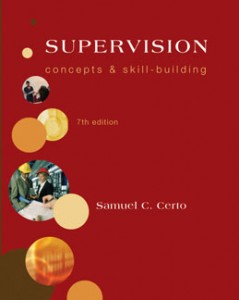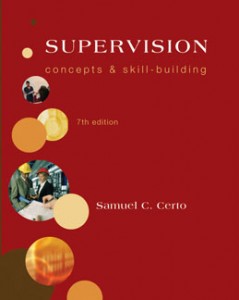Test Bank for Supervision Concepts and Skill Building, 7th Edition: Certo

Product details:
- ISBN-10 : 0071220453
- ISBN-13 : 978-0071220453
- Author: Certo
Certo’s ” Concepts and Skill-Building” prepares students to be supervisors in a challenging modern workplace. It is based on the premise that organizational variables including diversity in the workforce, computer and communication technology, and the design of organization structures are constantly changing. Overall, this text focuses on discussing important supervision concepts and providing fundamental skills necessary for applying these concepts. Students will learn the critical role of a supervisor in an organization and the abilities needed to be successful.
Table contents:
PART ONE WHAT IS A SUPERVISOR?
1(28)
Modern Supervision: Concepts and Skills
2(27)
Supervision: A Historical Perspective
4(2)
Supervisors Should Focus on Efficiency
4(1)
Supervisors Should Focus on Functions to Be Performed
5(1)
Supervisors Should Focus on People
5(1)
Types of Supervisory Skills
6(4)
Classic Understanding of Management Skills
6(1)
Modern View of Management Skills
7(1)
Supervising a Diverse Workforce
8(1)
Opportunities and Challenges
8(1)
Subtle Discrimination
9(1)
General Functions of the Supervisor
10(2)
Planning
10(1)
Organizing
11(1)
Staffing
11(1)
Leading
11(1)
Controlling
11(1)
Relationships among the Functions
12(1)
Responsibilities of the Supervisor
12(2)
Types of Responsibilities
13(1)
Responsibilities and Accountability
14(1)
Becoming a Supervisor
14(2)
Preparing for the Job
14(1)
Obtaining and Using Power and Authority
15(1)
Characteristics of a Successful Supervisor
16(4)
About This Book
18(2)
Concepts
20(2)
Summary
20(1)
Key Terms
21(1)
Review and Discussion Questions
21(1)
Skill-Building
22(5)
You Solve the Problem
22(1)
Problem-Solving Case: Refereeing the Referees of the Atlantic Coast Conference
22(1)
Assessing Yourself: Is Supervising Right for You?
23(1)
Class Exercise: Recognizing Management Skills
23(1)
Building Supervision Skills: Defining Your Role as Supervisor
24(1)
Building Supervision Skills: Leading a Team
25(2)
Video Cases
27(2)
PART TWO MODERN SUPERVISION CHALLENGES
29(110)
Ensuring High Quality and Productivity
30(36)
Consequences of Poor Quality
32(2)
Limited Resources
33(1)
Higher Costs
33(1)
Types of Quality Control
34(1)
Product Quality Control
34(1)
Process Control
35(1)
Methods for Improving Quality
35(6)
Statistical Quality Control
36(1)
Zero-Defects Approach
37(1)
Employee Involvement Teams
37(2)
Six Sigma
39(1)
Total Quality Management
40(1)
Quality Standards
41(2)
Guidelines for Quality Control
43(2)
Prevention versus Detection
43(1)
Standard Setting and Enforcement
43(2)
The Productivity Challenge
45(3)
Trends in Productivity in the United States
45(1)
Constraints on Productivity
46(2)
Measuring Productivity
48(2)
Improving Productivity
50(8)
Use Budgets
51(1)
Increase Output
52(1)
Improve Methods
52(1)
Reduce Overhead
52(1)
Minimize Waste
53(1)
Regulate or Level the Work Flow
54(1)
Install Modern Equipment
55(1)
Train and Motivate Employees
56(1)
Minimize Tardiness, Absenteeism, and Turnover
56(2)
Employee Fears about Productivity Improvement
58(4)
Concepts
59(1)
Summary
59(1)
Key Terms
60(1)
Review and Discussion Questions
60(2)
Skill-Building
62(4)
You Solve the Problem
62(1)
Problem-Solving Case: Fast Food Is All about Service
62(1)
Assessing Yourself: Test Your Personal Productivity
63(1)
Class Exercise: Defining and Measuring Quality of Service
63(1)
Building Supervision Skills: Improving Performance
64(2)
Groups, Teams, and Powerful Meetings
66(30)
Reasons for Joining Groups
68(1)
Groups in the Workplace
69(3)
Functional and Task Groups
69(1)
Formal and Informal Groups
69(1)
Getting the Group to Work with You
70(2)
Characteristics of Groups
72(3)
Roles
72(1)
Norms
73(1)
Status
74(1)
Cohesiveness
74(1)
Size
74(1)
Homogeneity
75(1)
Effectiveness
75(1)
Teams
75(7)
Stages of Team Development
76(1)
Benefits of Teamwork
77(1)
Leading the Team
78(4)
Powerful Meetings
82(5)
Reasons for Meetings
82(1)
Preparing for a Meeting
83(2)
Conducting a Meeting
85(2)
Overcoming Problems with Meetings
87(1)
Concepts
87(3)
Summary
87(2)
Key Terms
89(1)
Review and Discussion Questions
89(1)
Skill-Building
90(6)
You Solve the Problem
90(1)
Problem-Solving Case: Peer Groups Help Eastman Kodak Employees Resolve Disputes
91(1)
Assessing Yourself: How Do You Communicate as a Team Leader?
92(1)
Class Exercise: Meeting Participation Skills
93(1)
Building Supervision Skills: Evaluating Team Performance
93(3)
Corporate Social Responsibility and Ethics
96(20)
Fundamentals of Corporate Social Responsibility
97(2)
The Davis Model of Corporate Social Responsibility
98(1)
Ethics in the Workplace
98(1)
Benefits of Ethical Behavior
99(6)
Challenges to Ethical Behavior
100(1)
Differing Measures of Ethical Behavior
101(3)
Code of Ethics: An Example
104(1)
Ethical Behavior of Supervisors
105(3)
Making Ethical Decisions
106(1)
Supervising Unethical Employees
107(1)
Treatment of Whistle-Blowers
108(2)
Concepts
110(2)
Summary
110(1)
Key Terms
111(1)
Review and Discussion Questions
111(1)
Skill-Building
112(4)
You Solve the Problem
112(1)
Problem-Solving Case: Lawyers, Ford, and Firestone: Who’s to Blame?
112(1)
Assessing Yourself: How Ethical Is Your Behavior?
113(1)
Class Exercise: Supervising Unethical Employees
114(1)
Building Supervision Skills: Decision Making
114(2)
Managing Diversity
116(23)
What Is Diversity?
117(1)
A Look at Our Diversity
118(1)
Challenges to Working in a Diverse Society
119(8)
Prejudice and Discrimination
120(2)
Stereotypes
122(1)
Sexism
122(3)
Ageism
125(1)
Accommodation of Disabilities
126(1)
Implications for the Supervisor
127(5)
Advantages of Diversity
127(1)
Communication
128(1)
Diversity Training
129(2)
Legal Issues
131(1)
Concepts
132(2)
Summary
132(1)
Key Terms
133(1)
Review and Discussion Questions
133(1)
Skill-Building
134(3)
You Solve the Problem
134(1)
Problem-Solving Case: Wal-Mart Struggles with Diversity
134(1)
Assessing Yourself: Avoiding Age Bias
135(1)
Class Exercise: Managing Diversity
136(1)
Building Supervision Skills: Providing Employee Orientation
136(1)
Video Cases
137(2)
PART THREE FUNCTIONS OF THE SUPERVISOR
139(114)
Reaching Goals: Plans and Controls
140(34)
Planning in Organizations
141(8)
Objectives
142(3)
Policies, Procedures, and Rules
145(2)
Action Plans
147(1)
Contingency Planning
148(1)
Management by Objectives
149(1)
The Supervisor as Planner
149(6)
Providing Information and Estimates
150(1)
Allocating Resources
150(4)
Involving Employees
154(1)
Planning with a Team
154(1)
Updating Objectives
154(1)
The Supervisor as Controller
155(10)
The Process of Controlling
155(7)
Types of Control
162(1)
Tools for Control
162(3)
Characteristics of Effective Controls
165(1)
Timeliness
165(1)
Cost Effectiveness
165(1)
Acceptability
166(1)
Flexibility
166(1)
Concepts
166(3)
Summary
166(1)
Key Terms
167(1)
People also search:
Supervision Concepts and Skill Building
Supervision Concepts and Skill Building Certo
Supervision Concepts and Skill Building Certo 7th
Supervision Concepts and Skill Building Certo 7th Test Bank
Test Bank for Supervision Concepts and Skill Building, 7th Edition: Certo Download





